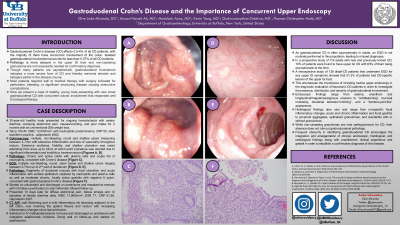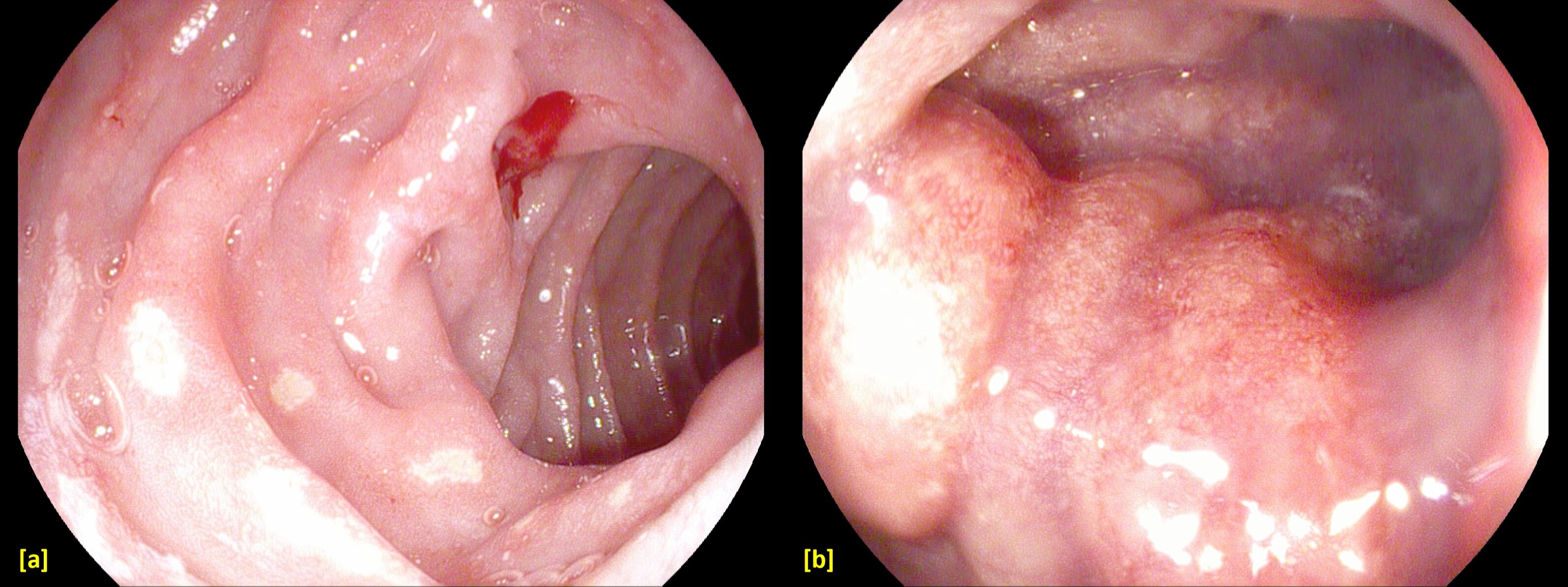Back


Poster Session A - Sunday Afternoon
Category: IBD
A0399 - Gastroduodenal Crohn's Disease and the Importance of Concurrent Upper Endoscopy
Sunday, October 23, 2022
5:00 PM – 7:00 PM ET
Location: Crown Ballroom

Has Audio

Clive J. Miranda, DO
University at Buffalo
Buffalo, NY
Presenting Author(s)
Clive J. Miranda, DO, Murad H. Ali, MD, Muddasir Ayaz, MD, Kevin Yang, MD, Chukwunonyelum Odukwe, BS, Thomas C. Mahl, MD
University at Buffalo, Buffalo, NY
Introduction: Gastroduodenal Crohn’s disease (CD) is an unusual phenomenon affecting 0.5-4% of all CD patients. First described by Gottlieb in 1937, the majority of these individuals have concurrent involvement of the colon with isolated gastroduodenal disease accounting for less than 0.07% of all CD patients. Pathology is more obscure in the upper gastrointestinal (GI) tract than with ileocolonic CD and non-caseating granulomas – a hallmark of distal CD – are not necessarily needed for confirmatory diagnosis. Often, only focal gastritis, lymphoid aggregates and other nonspecific inflammatory changes are noted on histopathology. Though many patients are asymptomatic, gastroduodenal involvement highlights a more severe form of CD and thus warrants steroid treatment and biological agents earlier in the disease course.
Case Description/Methods: A healthy 30-year-old male presented with 3 months of hematemesis, watery diarrhea, and abdominal pain for with a 30lb weight loss. He had a leukocytosis of 12,000 with neutrophilic predominance. A colonoscopy showed significant ileocolonic mucosal ulceration throughout the rectum with an inability to traverse the sigmoid due to significant inflammation. Pathology was confirmatory for new onset CD. An esophagogastroduodenoscopy (EGD) showed focal gastritis and shallow ulceration up to the 2nd part of the duodenum with pathology consistent with concurrent gastroduodenal CD. He was discharged on infliximab but returned with a flare due to noncompliance. He was then trialed on an adalimumab-azathioprine regimen with good remission and maintenance response.
Discussion: Current literature is bereft of controlled studies assessing the efficacy of medication for the treatment of CD in the upper GI tract and treatment is therefore based on a combination of distal disease activity and clinical experience. As gastroduodenal CD is usually asymptomatic in adults, often an EGD is not routinely performed. We emphasize the importance of including routine upper endoscopy in the diagnostic evaluation of ileocolonic CD patients to investigate the presence, distribution, and severity of gastroduodenal involvement. Furthermore, the frequent obscurity in identifying gastroduodenal CD on endoscopy and pathology encourages the integration and amalgamation of clinical, endoscopic, histological, and radiological findings along with practitioners’ clinical experience and gestalt in order to establish a confirmatory diagnosis of this disease.

Disclosures:
Clive J. Miranda, DO, Murad H. Ali, MD, Muddasir Ayaz, MD, Kevin Yang, MD, Chukwunonyelum Odukwe, BS, Thomas C. Mahl, MD. A0399 - Gastroduodenal Crohn's Disease and the Importance of Concurrent Upper Endoscopy, ACG 2022 Annual Scientific Meeting Abstracts. Charlotte, NC: American College of Gastroenterology.
University at Buffalo, Buffalo, NY
Introduction: Gastroduodenal Crohn’s disease (CD) is an unusual phenomenon affecting 0.5-4% of all CD patients. First described by Gottlieb in 1937, the majority of these individuals have concurrent involvement of the colon with isolated gastroduodenal disease accounting for less than 0.07% of all CD patients. Pathology is more obscure in the upper gastrointestinal (GI) tract than with ileocolonic CD and non-caseating granulomas – a hallmark of distal CD – are not necessarily needed for confirmatory diagnosis. Often, only focal gastritis, lymphoid aggregates and other nonspecific inflammatory changes are noted on histopathology. Though many patients are asymptomatic, gastroduodenal involvement highlights a more severe form of CD and thus warrants steroid treatment and biological agents earlier in the disease course.
Case Description/Methods: A healthy 30-year-old male presented with 3 months of hematemesis, watery diarrhea, and abdominal pain for with a 30lb weight loss. He had a leukocytosis of 12,000 with neutrophilic predominance. A colonoscopy showed significant ileocolonic mucosal ulceration throughout the rectum with an inability to traverse the sigmoid due to significant inflammation. Pathology was confirmatory for new onset CD. An esophagogastroduodenoscopy (EGD) showed focal gastritis and shallow ulceration up to the 2nd part of the duodenum with pathology consistent with concurrent gastroduodenal CD. He was discharged on infliximab but returned with a flare due to noncompliance. He was then trialed on an adalimumab-azathioprine regimen with good remission and maintenance response.
Discussion: Current literature is bereft of controlled studies assessing the efficacy of medication for the treatment of CD in the upper GI tract and treatment is therefore based on a combination of distal disease activity and clinical experience. As gastroduodenal CD is usually asymptomatic in adults, often an EGD is not routinely performed. We emphasize the importance of including routine upper endoscopy in the diagnostic evaluation of ileocolonic CD patients to investigate the presence, distribution, and severity of gastroduodenal involvement. Furthermore, the frequent obscurity in identifying gastroduodenal CD on endoscopy and pathology encourages the integration and amalgamation of clinical, endoscopic, histological, and radiological findings along with practitioners’ clinical experience and gestalt in order to establish a confirmatory diagnosis of this disease.

Figure: [a] View of proximal duodenum via upper endoscopy showing multiple non-bleeding, round, clean based and shallow ulcers ranging between 3-7mm
[b] View of sigmoid colon via colonoscopy showing extensive ulceration and friability
[b] View of sigmoid colon via colonoscopy showing extensive ulceration and friability
Disclosures:
Clive Miranda indicated no relevant financial relationships.
Murad Ali indicated no relevant financial relationships.
Muddasir Ayaz indicated no relevant financial relationships.
Kevin Yang indicated no relevant financial relationships.
Chukwunonyelum Odukwe indicated no relevant financial relationships.
Thomas Mahl indicated no relevant financial relationships.
Clive J. Miranda, DO, Murad H. Ali, MD, Muddasir Ayaz, MD, Kevin Yang, MD, Chukwunonyelum Odukwe, BS, Thomas C. Mahl, MD. A0399 - Gastroduodenal Crohn's Disease and the Importance of Concurrent Upper Endoscopy, ACG 2022 Annual Scientific Meeting Abstracts. Charlotte, NC: American College of Gastroenterology.
